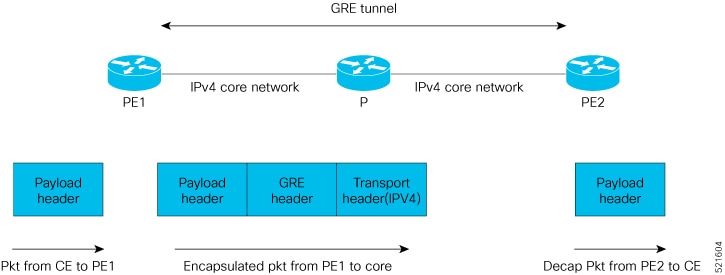Restrictions
-
Tunnel destination under VRF and command tunnel vrf is not supported. Tunnel destination prefix must be in global routing table for IPV4 unicast GRE to be functional.
-
Convergence lesser than 50 msec is not guaranteed.
-
Maximum supported GRE scale is 510.
-
Tunnel key is not supported. Hence, you must configure unique pair of source or destination IP address per tunnel.
-
ACL and QoS are not supported over GRE tunnel.
-
Time To Live (TTL) and Type of Service (TOS) are supported in Pipe mode.
-
Tunnel Interface Statistics is not supported.
-
Maximum Transmission Unit (MTU) is not supported for GRE tunnel and hence path MTU is also not supported.
-
Recursive routing is not supported as control plane support is not available.
-
Netflow and Policy-Based Routing (PBR) are not supported over the GRE tunnel.
-
GRE over Virtual Private LAN Services (VPLS) or PW is not supported.
-
GRE with indirection LB, Prefix Independent Convergence (PIC) core or PIC Edge, is not supported.
-
GRE over Traffic Engineering (TE) tunnel core (mid-chain pointing to mid-chain support) is not supported.
-
Equal-Cost Multi-Path Routing (ECMP) or load balancing between GRE tunnels is not supported. But, when you can configure LB paths for a single GRE tunnel, the tunnel uses only one of the paths.
-
Bidirectional Forwarding Detection (BFD) over IPv4 unicast tunnel is not supported.
-
MPLS over GRE tunnel and GRE over MPLS are not supported.
-
GRE tunnel works with max-ipv4-tunnel template only. This is not applicable to Cisco RSP3 module.
-
GRE over BDI core is not supported.
-
Tunnel checksum is not supported.
-
System-to-Intermediate System (IS-IS) over tunnel is not supprted.
-
ECMP for GRE tunnels is not supported.
-
QoS over tunnel is not supported.
-
GRE Tunnel Recursive loop formed with ip unnumbered loopack x is not supported.



 Feedback
Feedback